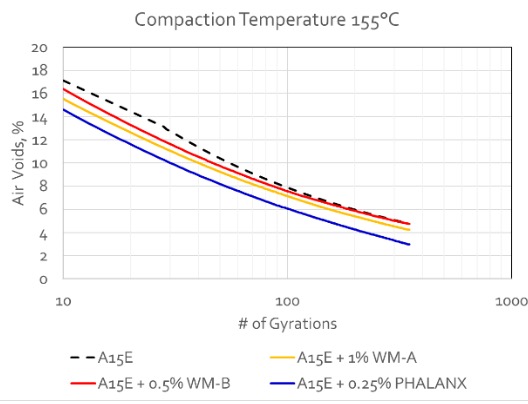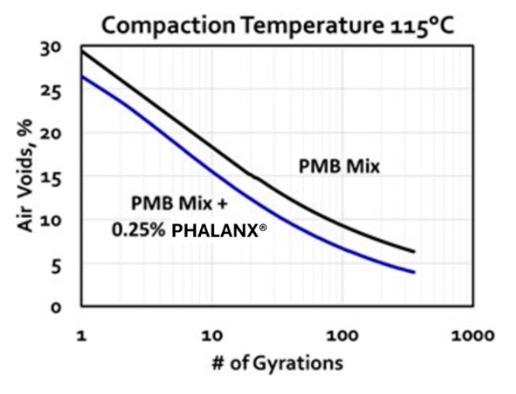
With concerns around sustainability in asphalt increasing across the paving industry, more mix engineers are turning to warm mix asphalt (WMA) to design paving mixes that help reduce emissions while continuing to meet performance specifications. Currently, over 40% of asphalt pavement construction in the United States uses warm mix asphalt technology. Additionally, agencies such as Highways England are exploring the shift to WMA in order to meet their net zero emissions goals.
Key to the concept of warm mix asphalt is the ability to lower production and paving temperatures without sacrificing long-term performance of the roadway surface. Temperature ranges for warm mix asphalt vs. hot mix asphalt can be considerable, anywhere between 30 to 120°F different, depending on the mix design and use of warm mix additives that enable lower temperature use without changing binder characteristics such as PG Grade or Penetration Point.
Warm mix asphalt production temperature ranges are typically between 115-135°C (240-275°F) and compacted at temperatures above 107°C (225°F). In contrast, hot mix asphalt (HMA) is produced between 135-177°C (275-350°F) and compacted at temperatures between 104-143°C (220-290°F).
This significant difference in temperature ranges between WMA and HMA is what can make warm mix asphalt more energy and cost efficient. Not only are production and compaction temperatures reduced, which means less fuel consumption to heat the mix, but also the reduced energy use can lower carbon emissions throughout the process. Lower energy consumption can also help lower production expenses during mixing and transportation to the job site.
However, there is much more to warm mix asphalt than simply lowering temperatures. For a mix to exhibit the performance specifications required by contractors and departments of transportation, a warm mix additive is needed in the mix. A WMA for asphalt is believed to work by lowering the viscosity of the binder in the mix, reducing friction, improving wettability, and lubricating the aggregates for improved workability.
Warm mix additives in asphalt can be used to lower the production and paving temperatures of a variety of mixes including those with neat binders, polymer modified bitumen, virgin materials, or reclaimed asphalt pavement (RAP). This is because warm mix additives for bitumen do not impact binder characteristics.
Importantly, dosing a mix with a warm mix additive can improve compaction at lower temperatures. For example, Sripath's warm mix additive, PHALANX®, is a specially engineered molecule designed to reduce mix production and compaction temperatures while improving compactability. Independent testing has shown that even at temperatures as low as 115°C, warm mixes dosed with PHALANX demonstrate superior compactability compared to WMAs formulated using synthetic pellets or fatty amine derivative liquid warm mix additives. This data and the corresponding graph were provided through independent testing conducted by the Royal Melbourne Institute of Technology.
Overall, warm mix additives present an opportunity for mix designers to optimize their mixes for production and paving at lower temperatures while saving costs and energy. Improved compaction can also help extend the life of the roadway surface, further reducing expenses while also providing for more sustainable pavements requiring less frequent repair and replacement.
Using the right warm mix additive for specific mixes and use cases is critical to achieving the lowest of feasible compaction temperatures. According to NAPA, 59.4% (103.9 million tons) of total tonnage produced via warm mix asphalt technology resulted in a temperature reduction of at least 10°F. There is clearly more room for the industry to explore reduced temperature ranges for WMAs that can benefit producers, contractors, and the environment.
For more information about PHALANX and how warm mix asphalt in paving can help support sustainability efforts, contact info@sripath.com.

